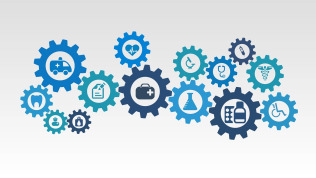 The march toward value-based care has prompted a seemingly endless number of vendors to claim they have the ‘secret sauce’ that will help health systems and vendor partners succeed in an ever-evolving market.
The march toward value-based care has prompted a seemingly endless number of vendors to claim they have the ‘secret sauce’ that will help health systems and vendor partners succeed in an ever-evolving market.
With so many options, decision-makers must separate false promises from real opportunities and identify the companies that will have staying power. Taking a thoughtful and strategic approach to analyzing options will help identify beneficial long-term partners. Continue reading

 Driving toward value-based care first requires a healthy understanding of the environment in which we are operating. Though regularly criticized, the U.S. healthcare system is actually strong: we have some of the world’s best hospitals and doctors. Individual service lines can provide attentive and effective care, whether it is cardiology, endocrinology or oncology.
Driving toward value-based care first requires a healthy understanding of the environment in which we are operating. Though regularly criticized, the U.S. healthcare system is actually strong: we have some of the world’s best hospitals and doctors. Individual service lines can provide attentive and effective care, whether it is cardiology, endocrinology or oncology. The healthcare IT industry enters 2018 with a lot of potential, along with the need to overcome structures that have historically stunted progress. What is on our health IT wish list? AirStrip is feeling optimistic about the industry’s direction in terms of broader collaboration for building up
The healthcare IT industry enters 2018 with a lot of potential, along with the need to overcome structures that have historically stunted progress. What is on our health IT wish list? AirStrip is feeling optimistic about the industry’s direction in terms of broader collaboration for building up  This past year, 2017, has been a challenging year for many industries, and healthcare is certainly no exception. Not only are there major challenges connected to an increasingly aging population and outdated healthcare infrastructure, but the industry is also adapting to the policies associated with a new presidential administration. While
This past year, 2017, has been a challenging year for many industries, and healthcare is certainly no exception. Not only are there major challenges connected to an increasingly aging population and outdated healthcare infrastructure, but the industry is also adapting to the policies associated with a new presidential administration. While  As we celebrate
As we celebrate  Over the past couple of years, there have been around 200 merger and acquisition (M&A) deals in the healthcare IT space, driven by high enterprise value and the sheer size of the industry. 49 deals came together in the first quarter of this year alone. These numbers make
Over the past couple of years, there have been around 200 merger and acquisition (M&A) deals in the healthcare IT space, driven by high enterprise value and the sheer size of the industry. 49 deals came together in the first quarter of this year alone. These numbers make Over the last few years, the healthcare industry has undergone an incredible revolution.
Over the last few years, the healthcare industry has undergone an incredible revolution. 
 Across the country, health care organizations are re-envisioning how to deliver care. Major health systems like Lahey Health are seeking out new solutions that allow us to transition from episodic care to wellness – minimizing the impact of disease and managing the health of populations more effectively. At the same time, patients continue to demand more from their care providers. We now must bring care to patients at the time and location of their choosing, and this is the beginning of the consumerization of healthcare. These shifts require technology that can provide more comprehensive and context-aware views of patients’ data, support for collaborative care across the continuum, and allow health systems to scale their delivery of care in new ways. Consequently,
Across the country, health care organizations are re-envisioning how to deliver care. Major health systems like Lahey Health are seeking out new solutions that allow us to transition from episodic care to wellness – minimizing the impact of disease and managing the health of populations more effectively. At the same time, patients continue to demand more from their care providers. We now must bring care to patients at the time and location of their choosing, and this is the beginning of the consumerization of healthcare. These shifts require technology that can provide more comprehensive and context-aware views of patients’ data, support for collaborative care across the continuum, and allow health systems to scale their delivery of care in new ways. Consequently,  For over a year, the US has spent much of its time wondering who would be the next Commander-in-Chief, and what the implications would be with a Hillary Clinton or a Donald Trump presidency. Now that we have our answer – that Donald Trump will be leading the nation for at least the next four years – people across all industries are wondering how a new administration will impact their business.
For over a year, the US has spent much of its time wondering who would be the next Commander-in-Chief, and what the implications would be with a Hillary Clinton or a Donald Trump presidency. Now that we have our answer – that Donald Trump will be leading the nation for at least the next four years – people across all industries are wondering how a new administration will impact their business.